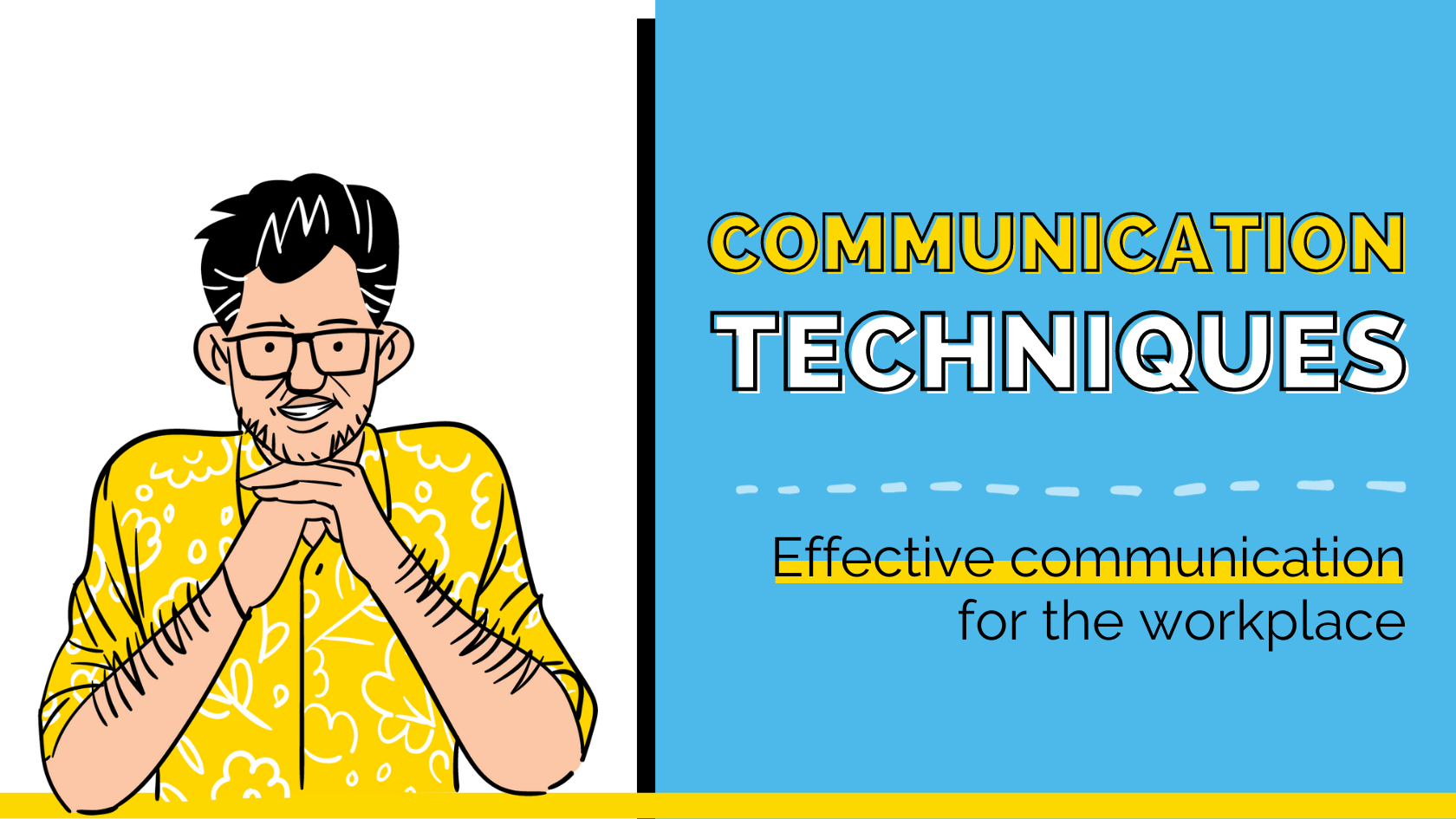We’ve all been there – moments when we thought we were on the same page with someone, only to discover that we were not only on different pages but reading different books. In different genres. In different languages.
In the workplace, these kinds of misfires have an insidious effect. It feels like a slight hiccup at the time, but out-of-sync misunderstandings make for precious time wasted on the wrong problems and create low morale, and working relationships that end up sub-optimal.
The good news is that this isn’t inevitable. In fact, you can learn to sharpen your communication skills.
The following communication techniques will help you get information across clearly, give space to other people to figure things out and help you build the right kind of working relationships along the way.
1. Know What’s Essential to Communicate
Everybody knows the importance of crystal-clear communication, but how do you actually put it into practice?
I’ve found that it’s often helpful to have a mental model to guide you as you go. What this does is allow you to share information in a way that’s easily absorbed.
Before you enter a conversation, ask yourself some questions – what do you want, and what do you want the other person to do or know?
Whether it’s one thing or (at most, I’d suggest) three, take the time to meditate on what you’re actually going to ask for.
Once you’re clear on what those things are, you can then begin the conversation by sign-posting that you have X number of things to discuss. This approach enables you to get to the heart of things without dilly-dallying around the subject or getting veered off track.
2. Establish How to Work Before You Begin
PowerPoint presentations are banned in important meetings at Amazon
Instead, the person looking for a decision writes out their case beforehand, and then the attendees spend the first 10 minutes reading the document before getting into it.
The Amazon way reminds me a lot of what I call the Keystone Conversation, the central tactic in my new book How To Work With (Almost) Anyone.
The Keystone Conversation improves workplace communication right off the bat by establishing three things:
- A shared responsibility between you and the other person for the health of your working relationship. Think about how you communicate, each other’s expectations, and so forth.
- Permission to discuss how things are going later down the line – both good and bad.
- A deeper understanding of the human across the table from you.
Importantly, the Keystone Conversation is all about the way you work together, not the projects you’re working on. By better understanding each other’s working styles, you lay the groundwork for clear and concise communication in the future.
Here are some of the questions I recommend asking:
- What are your practices and preferences?
- What can you learn from successful past relationships?
- How will you fix it when things go wrong?
And remember, these questions apply to you as well. Before engaging with others in one of these conversations, take a moment to reflect on your own responses.
This self-awareness enables you to approach the conversation authentically and openly, setting the stage for the other person to do the same.
3. Stay Curious a Little Longer
Most people are advice-giving maniacs. We just love to give others answers and mistakenly think we’re communicating wonderfully in the process.
But the truth is, more often than not, the secret to effective communication techniques lies in embracing curiosity and empowering others.
Think of it this way – whenever you dish out advice, you’re subconsciously telling the other person that their thoughts and ideas aren’t useful, and this drains their autonomy and sense of motivation.
When you move from advice-giving to staying curious, you build a better rapport with the other person. You’re showing them that you value what they think and that you’re on the same level. This motivates them and makes them more likely to listen to you in turn.
Questions are the fuel of curiosity. Here are some of my favorites from my book The Coaching Habit to get you started:
- What’s on your mind?
- What is the real challenge here for you?
- What do you want?
4. Get Comfortable With Silence
I know. This heading is dreadfully contradictory. After all, how can you communicate if you’re silent?
Well, becoming comfortable with silence as a communication technique does two things. Firstly, it allows the other person to find the space to talk, which is particularly helpful if they’re an introvert rather than an extrovert.
Secondly, it allows you to think before you decide what to say next. And, ironically, one thing I’ve noticed is that, if you want people to pay attention to something you’re going to say, be silent and then make the point.
The silence actually gives what follows more weight, and this is something you actually see play out on stage a lot.
When the actor has something really important to say, they stop moving. This sudden stillness draws the audience’s attention. It signifies to them that the actor is going to communicate something that really matters.
The same goes for silence. Be generous with it, and people are more likely to listen.
5. Make Friends With Feedback
Put your hand up if you love giving feedback. No-one? I thought so.
Undoubtedly, feedback is one of the most daunting aspects of workplace communication. Even though it’s critical to progress and growth, the whole process can be nerve-wracking, awkward, and uncomfortable.
To make giving feedback suck less, try using Marshall Rosenberg’s nonviolent communication model, which has four elements:
- Data: The cold, hard facts – things you can point to and say, “This is true.”
- Your feelings. I like to play with five core feelings that rhyme – mad, sad, glad, ashamed, and afraid.
- Your judgments. Your opinions about the other person, yourself, and the situation at hand. This is where things can get a bit tangled.
- What you want and need.The request you’re itching to make as part of the conversation.
Before you offer any feedback, you’ll want to have a solid grip on the data and what you want and need.
Become aware of how your feelings and judgments are clouding things, and do your best to untangle these biases from the facts. That way, you’ll be able to give much more leveled, constructive feedback on someone’s work.
6. Make Sure Relationships Are Safe, Vital, and Repairable
Great communication only happens when the person you’re talking to feels secure. You want people to lean in, not pull back, to feel like speaking with you is a reward, not a risk.
Exceptional communicators achieve this by building relationships that are safe, vital, and repairable.
- Safe means psychological safety – creating a welcoming atmosphere where people feel comfortable bringing their authentic selves to work.
- Vital means amplifying the good – you challenge each other and help each other grow. It means you strive to reach your potential and bring out the best in each other.
- Repairable means you can fix what’s broken – you don’t let small mistakes or misunderstandings ruin your relationship, and you’re brave enough to apologize and forgive when things go wrong.
7. Find Focus
In our world of endless distractions, it’s too easy to get swept up in the chaos of our workday.
We’ve all been there, trying to juggle multiple tasks simultaneously – checking emails during conference calls, seamlessly switching between report writing and answering incoming calls.
However, multitasking is the enemy of effective communication techniques.
If you want to communicate better, you and the other person need to be fully present, even if you’re on Zoom.
One tip to make this happen is to start your meeting by asking everyone: “How focused can you be during this discussion?”
Then, introduce a focus scale, where one means a low level of focus, and seven means full attention.
If you can encourage the participants to make a single adjustment to their environment to help them boost their focus, you’ll set the stage for a more engaged and productive conversation.
8. Seek an I-Thou Relationship
According to Martin Buber, you have two types of relationships in your life – I/it relationships and I/thou relationships.
In “I/it” relationships, you see the other person as an object, a cog in a larger machine, rather than a human being. As a result, you lose your sense of their humanity and become less empathetic, kind, and compassionate.
Then, there are the I/thou relationships. That’s when you think bigger. You remember just who the other person is. You see them in their wholeness – their strengths, weaknesses, struggles, insecurities, their life outside of the four walls of the office.
In the business of the workplace, it’s very easy to slip into I/it relationships. You’re overwhelmed. You’ve got too much to do. You see your conversations with others as transactional, or even mechanical!
But here’s the thing. The magic of great communication lies in building I/thou relationships with the people around you.
When you try to show them your heart and try to see theirs, you tap into a new kind of energy. You become more curious, warm, and open, and this unlocks your ability to have more valuable interactions.
9. Stay Flexible
When it comes to effective communication techniques, sometimes it’s all about talking less and asking more, but that’s not always the case. There will be moments where you need to provide clear guidance and be assertive.
In fact, Daniel Goleman proposes that there are six leadership communication styles and that great leaders bounce between each seamlessly and quickly, depending on the context.
Figuring out the best communication style to use when you’re put on the spot can be difficult.
Luckily, lecturer Matt Abrahams recently shared some great strategies in Harvard Business Review:
Firstly, embrace active listening. No, not kind-of-listening or appear-to-be-listening. Actually be present and listen with your whole mind, so you can respond effectively to the situation at hand.
Secondly, dare to be dull. Yes, dull – that’s not a typo! You see, a lot of the time, people get anxious about whether they’re saying the right thing or judge themselves on what they should’ve or shouldn’t have said. The problem is that this mental chatter drains your cognitive batteries and stops you from being fully present.
Contrastingly, when you dare to be dull, you fully engage in the task at hand, foregoing the unrealistic expectations you have of yourself.
As Abrahams put it: “The more we can dare to be dull, the greater the chances we’ll be anything but dull – because we will be communicating using our full cognitive resources.”
10. Finish Strong
How you wrap up a conversation is just as important as the communication during the conversation.
Even if the dialogue was full of zest and energy, ending on a purposefully positive note will set the tone for great communication in the future.
So, at the end of an important conversation, ask this question: “What was most useful here for you?”
This simple question does two powerful things:
- It allows both of you to gather valuable data about what went well in the conversation, so you know what to do more of next time.
- By labeling the interaction as “useful”, you affirm to the other person that you found the interaction valuable, and that helps to cultivate psychological safety.
Master the Art of Effective Communication
The way we communicate with others has a ludicrously large influence on our happiness and success at work.
Don’t leave those interactions to fate – take charge, improve your communication skills, and unlock your greatness.
If you’d like to explore these concepts in more detail, I flesh them out in my newest book, How to Work With (Almost) Anyone.
Get your copy here!
